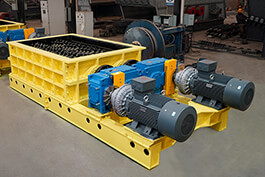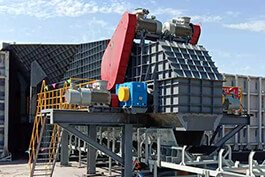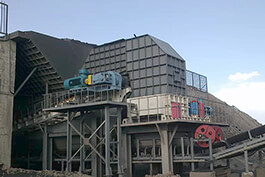Introduction
During the operation of the Mineral Sizer, the overload fracture of the safety pin of the coupling is a normal protective shutdown. At this time, a new pin must be replaced. There are three reasons for this:
I. After the pin fractures, it has undergone plastic deformation, and its mechanical strength has significantly decreased. It cannot guarantee the precise breaking torque when used again;
II. The damaged surface may cause stress concentration, leading to premature fracture under normal operating conditions;
III. The rated torque of the safety pin strictly matches the protection requirements of the main unit. Random replacement will disrupt the overload protection mechanism of the entire transmission system, endangering core components such as the reducer.
Reason for Replacing Safety Pins in Mineral Sizer Coupling During Overload
Protecting Key Components of the Equipment
The function of the safety pin
The safety pin is an important protective device in the Mineral Sizer system. It transmits torque to the working components of the mineral sizer during normal equipment operation. It accurately delivers the power required by the driving equipment to the mineral sizer's working components, ensuring the normal operation of the equipment.
The situation when the equipment is overloaded
If the feed volume suddenly increases or the hardness of the materials is abnormal, causing the mineral sizer to overload, the resistance borne by the components increases sharply, and the required torque exceeds the normal working range. Without the protection of the safety pin, the excessive torque will directly act on the coupling, the motor shaft, and other transmission components of the crusher, and the motor shaft may bend due to excessive torque, and the tooth surface of the coupling may be severely worn or even cracked.
Consequences of Damaged Key Components
Replacing and repairing the key components require professional skills and expensive parts. The repair cost is high, and the repair time is long, which will cause the mineral sizer to be shut down for a long time, seriously affecting production efficiency.
Overload protection function
When an overload occurs, the safety pin breaks first, promptly cutting off the power transmission, preventing further damage to the key components, and ensuring the stability and reliability of the entire Mineral Sizer system.

Restore the equipment to normal operation
Cost and characteristics
Compared with key components such as couplings and motor shafts, the manufacturing process and material cost of safety pins are lower. They are relatively simple and cost-effective components, offering economic advantages in the maintenance of the mineral sizer and reducing equipment maintenance costs.
Ease of replacement
Compared with repairing or replacing key components such as couplings and motor shafts, the replacement process is more convenient and faster. When overload causes the safety pin to break, replacing a new safety pin can quickly restore the normal operation of the Mineral Sizer. Usually, it only requires the use of simple tools and following the correct installation steps, and the replacement work can be completed within a short period of time.
Significance for production
Take mining enterprises with continuous production as an example. There are strict indicators for hourly output. If the Mineral Sizer is shut down for one hour, a large amount of output may be lost. Timely replacement of safety pins can avoid production losses caused by long-term shutdown and ensure the continuity of production.
Ensure safe operation of the equipment
Hidden danger of not replacing the safety pin
If the safety pin breaks and is not replaced in time, the coupling may exhibit abnormal movement and vibration after losing the constraint of the safety pin. This may cause collisions and friction between the coupling and surrounding equipment components, easily leading to safety accidents. The abnormal vibration of the coupling may also be transmitted to the entire equipment structure, causing the equipment foundation to loosen and even affecting the normal operation of other surrounding equipment.
The significance of replacing the safety pin
Replacing the safety pin can restore the normal working state of the coupling, ensure the stable operation of the equipment, eliminate the safety hazards caused by overload faults, and provide a safe and reliable working environment for operators and mineral sizers.
Replacement and maintenance of safety pins in mineral sizer coupling
Replacement
Tool Preparation
Prepare the disassembly tools suitable for the safety pin and related components, such as wrenches, pliers, etc. Different specifications require corresponding tools; otherwise, it may be impossible to disassemble or the components may be damaged. Also, prepare a new safety pin of the same specification, material, and performance as the original one, otherwise it will affect the safe operation of the mineral sizer.
On-site cleaning
Remove debris and dust around the coupling to prevent foreign objects from entering and affecting the equipment operation.
Locate the safety pin
Carefully observe the structure of the coupling and use marks or drawings to determine the position of the safety pin. This is the basis for subsequent disassembly. If the position is wrong, other components may be damaged.
Remove the fixed components
Use appropriate tools to remove the fixed components related to the safety pin, such as nuts, washers, etc., and keep them well for possible loss and subsequent installation.
Remove the old safety pin
Use pliers or other tools to pull out the old safety pin. If it is rusted or stuck, lubricate it first. Pay attention to the force and direction when pulling it out to avoid damaging the coupling hole wall.
Inspect the new safety pin
Before installation, recheck the specifications and quality of the new safety pin to ensure there is no damage or deformation, and avoid potential safety hazards.
Clean the pin hole
Use a clean cloth or brush to clean the coupling pin hole, remove debris and oil stains, and ensure the new safety pin fits better.
Insert the new safety pin
Carefully insert the new safety pin into the pin hole to ensure it is fully in place and closely fits. Pay attention to the direction and position, and inserting it wrongly will affect the fixation and equipment operation.
Install the fixed components
Install the fixed components such as nuts, washers, etc. in the reverse order of disassembly, and use tools to tighten them to ensure the safety pin is firmly fixed and the equipment operates safely.
Maintenance
Inspection cycle
Set a reasonable inspection period based on the usage frequency and working environment of the mineral sizer. For continuously operating equipment, it is recommended to conduct an exterior inspection weekly and a comprehensive inspection monthly; for intermittent operating equipment, the cycle can be extended, but a comprehensive inspection should be conducted at least every quarter. Due to the high safety load and wear of continuously operating equipment, more frequent inspections are required. For intermittent operating equipment, a certain inspection frequency must be maintained to ensure safety performance.
Exterior inspection
Observe whether there is any wear, cracks, or deformation on the surface of the safety pin. If there are obvious marks, it should be replaced promptly to prevent failure and accidents.
Fastening condition inspection
Check whether the fixing components of the safety pin, such as nuts and washers, are loose. If they are loose, they should be tightened promptly to avoid displacement or detachment that may affect operation.
Pin hole inspection
Check whether the pin holes of the coupling are worn, deformed or corroded. If the wear is severe, the coupling should be repaired or replaced to ensure the normal installation and use of the safety pin.
Lubrication cycle
Generally, lubrication and maintenance of the safety pin should be carried out every six months. If the working environment of the mineral sizer is harsh, such as high dust and high humidity, the cycle can be shortened to protect the safety pin and extend its lifespan.
Lubricant selection
Select an appropriate lubricant, such as lithium-based grease, which should have good lubrication, rust prevention and corrosion resistance to reduce friction and wear and prevent rust and corrosion.
Lubrication method
Apply an appropriate amount of lubricant on the surface of the safety pin and evenly cover it. Be careful not to enter other parts of the coupling to prevent affecting the operation of the equipment.






.jpg)






